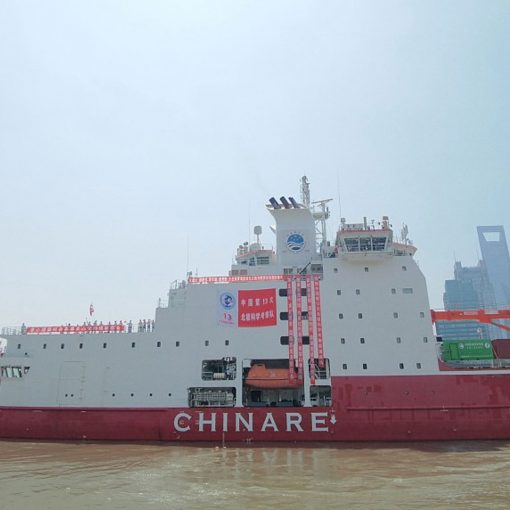Ken Hansen has posed an interesting question. It is not a question that is independent of other maritime concerns, namely ‘maritime blindness of the Canadian society’, the future of the Canadian navy, and the national interests of Canada. Irrespective of the scientific reasons for the climatic changes unfolding in the arctic, no one can reasonably deny that significant changes are occurring throughout the entire region and these changes directly affect Canada, Denmark (Greenland), Norway, Russia and the United States of America (the Sea Front Nations). These are the nation states with sea frontages on the Arctic Ocean.
There are many other nations with actual or potential commercial and other interests in the arctic region. As the sea ice melts and the climate moderates, scientific research, commercial and non-commercial ship traffic, mineral and petroleum exploration and exploitation, fishing, and tourism will all increase and bring with them the need for the 'Sea Front Nations' to regulate the wide variety of human activities, individually and collectively. In a federal state, such as Canada, this involves the federal government, several provinces and the three territories. There are therefore a multitude of governmental interests and agencies that have specific responsibilities over aspects of human endeavour.
The Canadian Forces, through its Joint Task Force North, interacts with a variety of federal, provincial, territorial and private sector entities, departments and agencies. Some matters relate to specific defence concerns while others are in aid of the civil power. All affect matters of national interest and involve national values. It is within this broad context that the Canadian Forces (and the Canadian navy) obtains its tasks and authority to carry out its functions. The Canada First Defence Strategy lists the national defence priorities as: (1) the defence of Canada, (2) the defence of North America, and (3) collective defence through international organisations, alliances and coalitions. Clearly, the defence of Canadian sovereign territory, air space and sea space is the primary task of the Canadian Forces and the navy. It is up to the political, military and naval leadership of Canada to meet this requirement responsibly and in a timely fashion.
The question is not, "Should the navy Return to the arctic?" but rather "How will the Canadian Forces, including the navy, execute its assigned tasks?" From a maritime perspective there are political and diplomatic issues to be resolved that will shape the nature of the military and naval response. Much will be decided in bilateral country level negotiations, through application of the provisions of the United Nations Law of the Sea Treaty, and the development on national, provincial and territorial laws. The military and naval response ideally will take the form of surveillance of the Canadian sovereign or managed air, land and sea spaces, the identification and investigation of potential intrusions, and the provision of counter penetration forces, as and when required. In addition there will be search and rescue activities, aid to civil authorities such as the Royal Canadian Mounted Police, Canadian Border Security Agency, the federal Department of the Environment, and provincial/territorial governments. These will be akin to constabulary type duties.
The navy will require command, control, communications, intelligence, surveillance, reconnaissance, armed response, scientific and logistic resources that are available on a persistent basis. Due to distance from the command facilities, bases and support organizations in southern Canada, the capabilities and skills acquired from the expeditionary activities dating from the Korean Conflict through today in the Indian Ocean, Persian Gulf and Afghanistan will have some relevance. For the navy this means that it must contribute to the whole of government approach by managing defence tasks on, over and under the Arctic Ocean. This does not appear to require an ice capable anti-air warfare destroyer but it does require an ice capable patrol vessel that has sufficient size and endurance to persistently contribute to the command, control, communications, surveillance, reconnaissance, scientific and armed response tasks. The Danes and Norwegians have developed their naval solutions which can be used as a baseline. The United States is thinking about its response; however, their only real naval response today is the nuclear powered attack and missile equipped submarines. The Russians have heavy icebreakers and nuclear powered ballistic missile and attack submarines in their fleet as well as scientific vessels. The Canadian navy needs a general purpose vessel that can conduct a wide variety of tasks within the context of space based surveillance systems, airborne surveillance and response resources, ground based air and coastal radars, electronic and communications intelligence gathering capabilities, as well as sea bottom sensors.
There is a job for the Canadian Forces and the navy up north. Is the leadership of the federal government, the Canadian Forces and the navy up to the challenge? Are Canadians so ambivalent about the north of our country that we are prepared to accede effective control of it to the other Sea Front Nations? As a taxpayer, I say it is time for Canadians, including its political, diplomatic, and military leaders to rise and meet the challenge. If that requires the navy to trade activities in the Persian Gulf and Indian Ocean for the Arctic Ocean, so be it. If that requires the army to curtail its expeditionary activities to provide resources for the defence of Canada, do it. While Canada ponders and debates, our international friends and competitors move forward.


